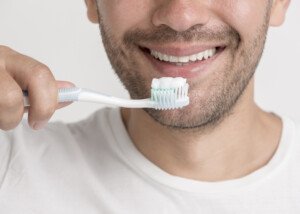As many as half the people in the United States currently have gum disease.
In fact, they have the more serious form called periodontitis.
Although it may not hurt right away, keep in mind that it progresses slowly and is the primary cause of tooth loss in adults.
Although there is no periodontitis cure, there is a way to bring it under control.
About Periodontitis
Periodontitis is caused by ignoring the first stages of gum disease. The first stage is called gingivitis and is rather mild.
The two symptoms are bleeding gums when you brush or floss your teeth, and your gums will appear inflamed.
Gum disease is caused by bacteria that are normally in your mouth but get out of control.
This usually occurs due to improper dental care. Without the care needed to reduce plaque on your teeth, it enables the bacteria to multiply and produce more acid which will irritate the gums.
Before long, the bacteria will get into the gums. Your immune system responds, attacking the gums, the support structures for your teeth, and your jawbone.
They are slowly being destroyed by the attack. Because it takes place below the gum line, you can’t remove the bacteria and stop your body’s attack.
Researchers have discovered that periodontitis will affect much more than just your gums and teeth.
The bacteria will circulate through your bloodstream and cause buildups in various places.
These can affect your health in many ways, contributing to health problems such as cardiovascular disease, heart attacks, stroke, cancer, dementia and many more.
Periodontitis Symptoms
If gingivitis is not treated, it will become periodontitis.
- Red and inflamed gums
- Bleeding gums
- Receding gums (which will also change the way dentures fit)
- Pockets forming on the gums
- Spaces developing between the teeth
- Chronic bad breath
- Painful chewing
- Loose teeth
- Teeth falling out
Periodontal Treatment
Eliminating the bacteria behind periodontitis will require the help of a dentist.
The dentist will first evaluate your condition and determine your level (out of four) of gum disease.
A gauge will be used to measure the depth of the pockets on your teeth, and X-rays will be taken of your teeth and jaw.
Non-Surgical Treatments
Periodontal treatment will vary with the severity of the gum disease.
The first step will usually be medications, which may involve pills taken orally, or, the dentist may insert antibiotic medications into the gum pockets in the form of a chip, gel or microspheres.
A procedure called scaling and root planing may also be conducted.
It’s a non-surgical procedure that involves physically removing the bacteria and inflammation from the pockets on the gums and then scraping the tooth roots to make them smooth.
Even better results may be obtained using a laser. It is faster and more thorough at destroying the harmful bacteria.
Surgical Treatments
In cases of advanced gum disease, surgical procedures will likely be necessary.
This may involve flap surgery, where the dentist cuts the gums to form a flap with one side still attached, and then pulls it over the exposed tooth roots on the tooth next to it.
Other forms of gum grafts may also be used.
If teeth have been lost, bone grafts may be necessary. This will restore the bone height in your jaw which was lost to reabsorption and the periodontal disease, and will enable dental implant insertion once the bone graft has healed.
The Periodontitis Cure
After the dentist conducts the necessary treatment, you will have the periodontitis cure you want.
You need to remember, though, that the bacterium that causes it is always present in your mouth.
This means that if you slack off on your oral care, it may come back. It’s impossible to completely rid your mouth of these bacteria.
Preventing Periodontal Disease
If you wait until you have developed periodontal disease to start taking better care of your teeth – you are too late.
Since you can’t remove it on your own, you need to do all you can to prevent it in the first place.
- Brush teeth twice a day – two minutes each time – with soft bristles.
- Floss daily – to remove plaque between your teeth.
- Stop using tobacco – it reduces oxygen and nutrients to the gums.
- Eat healthfully – it will keep your teeth and gums strong.
- Make regular visits to the dentist.
Once the periodontitis has been removed, you’ll likely require shorter intervals between dental exams.
This will enable further problems to be detected and treated before they become serious again.

Dr. Vadivel, DDS, is a board certified periodontal surgeon, and Founder-CEO of Implants & Gumcare of Texas, offering affordable restorative and cosmetic dental procedures. Dr. Vadivel has over 25 years of experience.
.










































